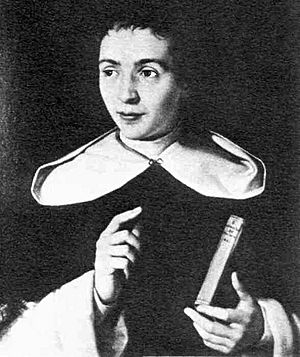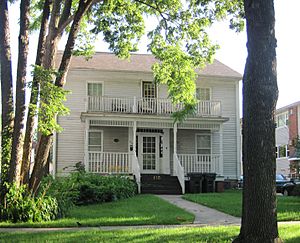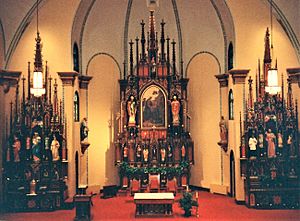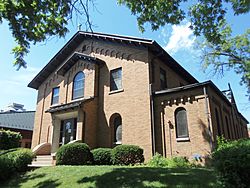St. Mary's Church and Rectory (Iowa City, Iowa) facts for kids
Quick facts for kids |
|
|
St. Mary's Church and Rectory
|
|
|
U.S. Historic district
Contributing property |
|
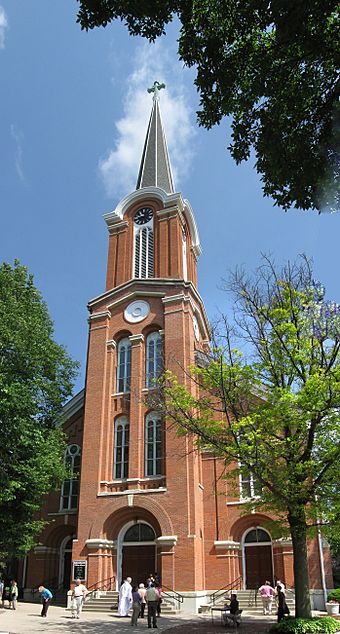 |
|
| Location | 220 E. Jefferson St. Iowa City, Iowa |
|---|---|
| Area | approximately 1 acre (0.40 ha) |
| Built | 1867 |
| Built by | Hugh Gilles A. Groebel J.J. Hotz |
| Part of | Jefferson Street Historic District (ID04001097) |
| NRHP reference No. | 80001454 |
| Added to NRHP | February 8, 1980 |
St. Mary's Catholic Church, also known as St. Mary of the Visitation Church, is a historic church in Iowa City, Iowa. It is a parish church of the Diocese of Davenport. The church building and its rectory (the priest's house) were added to the National Register of Historic Places in 1980. They are also part of the Jefferson Street Historic District. The very first rectory for the parish is now a private home. It is also listed on the National Register.
Contents
History of St. Mary's Church
Early Days of the Parish
The first Catholic Mass in what is now Iowa City happened on December 20, 1840. A missionary priest named Rev. Samuel Charles Mazzuchelli led the service. Twenty-eight people attended in a building that was both a home and a hotel. Today, the University of Iowa’s School of Business is on that spot. The day before, Father Mazzuchelli bought two lots for $2,000. These are the lots where the church and rectory stand today.
St. Mary's parish officially started in 1841. Father Mazzuchelli designed a small wooden church building. The first stone for this Greek Revival style church was placed on July 12, 1841. Bishop Mathias Loras of Dubuque oversaw this event. The church, called St. Mary of the Assumption, was mostly finished by 1842. Several priests visited to celebrate Mass there.
By 1844, the parish had grown to about 70 families. Rev. Anthony Godfert became the first full-time pastor. A year later, he started St. Joseph Cemetery. Father Godfert left in 1846. For the next two years, visiting priests served the parish. In 1848, Rev. F.B. Poyet became pastor. Since then, St. Mary's has always had a pastor. In the 1850s, the parish formed its first choir. A balcony was also added inside the church. The first rectory was built in 1853. Many German and Bohemian immigrants were joining the church. In 1862, St. Francis Xavier Church was built for Bohemian immigrants. That church burned down in 1869, and those families returned to St. Mary's.
Building the Current Church
Rev. William Emonds became the pastor in 1858. He served for 32 years. During his time, Catholic education grew, and the current church was built. He also helped start 44 other parishes and built churches in many of them.
At first, Father Emonds made the original church bigger. But soon, it was clear a new, larger church was needed. The first stone for the current church was laid on October 27, 1867. Hugh Gilles and A. Groebel were hired to build it. The new church was built around the old one. People continued to worship in the old church while the new one went up. Once the new roof was finished, the old building was taken down.
It took two years to build the main part of the church. The tall spire was finished later. When the new church was dedicated, it had its main altar, pews, pulpit, and stained glass windows. Bishop John Hennessey dedicated the church on August 15, 1869. It was named St. Mary of the Visitation Church. This was the first church to be officially blessed in the Diocese of Dubuque. Building the church cost $75,000. The tower was finished in 1873, and the spire and cross were added in 1874. A set of 17 bells, called a carillon, was added to the tower in 1885.
Parish Growth and Changes
St. Mary's parish was divided as other churches were built in Iowa City. St. Patrick's was founded in 1872. Their church was built in 1879. Another church for the Bohemian community, St. Wenceslaus, was founded in 1891. St. Thomas More started in 1944 as a student center before becoming its own parish.
In 1881, St. Mary's parish became part of the new Diocese of Davenport. In 1891, the old rectory was moved four blocks away. The current rectory was built the next year. Msgr. Aloysius Schulte was the pastor then, and he served the parish for almost 50 years. The new rectory was designed to match the church. It cost $8,000 to build.
The church building was updated in 1908. This included adding sixteen buttresses to make the building stronger. A new cross and spire were built, and a basement was dug under the church. The inside of the church was also redecorated. J.J. Hotz, a local builder, did the buttressing work. The church was redecorated again in 1941 for the parish's 100th birthday. The current pews were added then.
After the Second Vatican Council, changes were made to how Mass was celebrated. A new altar was added so the priest could face the people. Masses were now said in English instead of Latin. More updates happened in the early 1980s. The pipe organ was rebuilt in 1981. A parish hall was built in the church basement in 1982. The church interior was redecorated in 1983. This renovation included removing the communion rail, adding new carpet, and moving the tabernacle to a side altar. Around 2000, the church was redecorated again. The baptismal font was moved near the front door, and new carpet was installed.
The parish council started in 1969. From 1971 to 1980, Father Morrissey and Father Carlos Leveling served as co-pastors. In 1986, the parish began giving a percentage of its income to charity. Around the same time, the parish offices moved out of the rectory to a house next to the church. In 1988, the church tower was rebuilt. Another house was added to the parish offices in 1992, creating more office space. The parish also hired its first youth minister. Today, about 1,700 families belong to St. Mary's parish.
Architecture of the Church
The church is built from red brick on a stone foundation, with stone decorations. It has a Romanesque Revival style, seen in the round arches of its entrances, windows, and bell tower. However, its tall, upright shape also reminds us of the Gothic Revival style. The sides of the church have seven sections, separated by buttresses. Each section has a stained glass window.
The front of the church has a large, two-part bell tower with an octagon-shaped spire on top. The main entrance is at the base of the tower. There are also narrower entrances on either side of the tower. These three entrances have round arches with limestone keystones. Above the main entrance are two pairs of round arch windows. Above these is the bell chamber, which has arched tops to fit a clock on each side of the tower. The building has a gable roof.
Inside, the church is a large open space, about 65 by 145 feet, with no columns. The arches of the vaulted ceiling rise high on the walls. The tall wooden high altar was made by Alert and Kloustie. It features a painting of the Visitation, with statues of Saint Patrick and Saint Boniface on either side. Above the painting is a statue of Saint Anne with Mary as a child. The lower part of the altar has statues of the Four Evangelists.
The altar dedicated to the Blessed Virgin Mary was put in place in 1872. It has a main statue of Mary, with statues of Saints Bernard of Clairvaux and Bonaventure on either side. Below them are carvings of Old Testament Prophets like Moses and David. The Saint Joseph altar was installed in 1900. It features a main statue of Joseph, flanked by Saints Aloysius Gonzaga and Anthony of Padua. The Moline pipe organ, still used today, was installed in 1883 in the back balcony. Along the side walls of the main part of the church, called the nave, are statues of the Twelve Apostles.
The rectory (priest's house) is a wood-frame building, about 47 by 67 feet, covered with brick veneer. It has a pointed hip roof and large gabled sections on the east and south sides. The front of the house is not perfectly balanced. It has a window section that sticks out and a large porch with big semicircular brick arches. These arches match the Romanesque Revival style of the church.
St. Mary's School
In 1844, Father Godfert started the parish's first school in the church basement. Miss Norma O'Connor was the first teacher. The Sisters of Charity of the Blessed Virgin Mary came to Iowa City in 1860 to teach at St. Mary's. They also opened St. Agatha's Seminary, a school for girls, in 1861. In 1865, Father Emonds started St. Joseph Institute, a school for advanced learning. It was taught by lay teachers and closed around 1890.
In 1892, the parish bought land for a new school building. The first stone for the new school was laid on September 11, 1892. The new school opened in 1893. Franciscan Sisters taught there until 1895, when the Sisters of Charity of the Blessed Virgin Mary returned. In 1897, high school grades were added. This was the first Catholic high school in Iowa to be approved by the State University of Iowa.
In 1911, an addition was built onto the school. It included an auditorium and a cafeteria. A convent (a home for the sisters) was also built. This convent was replaced by the current building in 1926, which is now part of the Newman Center. The new convent cost $33,000.
In 1958, St. Mary's and St. Patrick's junior and senior high schools combined to form Regina High School. The St. Mary's School building started to wear out and closed in 1968. The elementary school then combined with St. Patrick's and used its building. The sisters continued to live in the St. Mary's Convent. In 1975, the St. Mary's school buildings and convent were sold to the diocese. They are now used by the Newman Center. In the early 1990s, Regina High School added an extension, and the elementary grades moved there from St. Patrick's.
The school building was listed on the National Register of Historic Places as St. Mary's High School in 1977. It was removed in 1997 after the buildings were torn down.
Pipe Organ Details
The Moline pipe organ, installed in 1883, is located in a balcony at the back of the church. It has a traditional console with a keyboard cover that can become a music stand. The organ has three keyboards, 31 stops, and 30 sets of pipes. It uses mechanical actions for both keys and stops. The organ was carefully restored in 2015.




